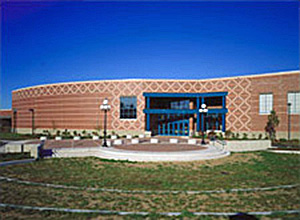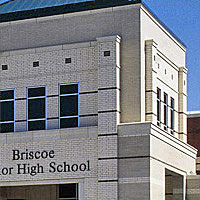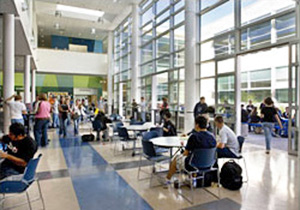Overview
Within This Page
Secondary school buildings provide the setting for the second phase of a child's formal, compulsory education in the United States—high school or grades 9 through 12. The Elementary and Secondary Education Act (ESEA), first enacted in 1965 and reauthorized by the No Child Left Behind Act, is the principal federal law that affects kindergarten through 12th grade (K–12). The Whole Building Design Guide includes "community" colleges in the secondary school category. Community colleges and high schools are similar in scale and connection to the community. Indeed, community colleges often serve as bridges between high school and a four-year college or university.
Building Attributes
Like elementary schools, secondary school buildings have the potential to enhance or undermine the learning process. They need to be comfortable, healthful, safe, and secure. Community colleges and high schools, often intended as joint-use facilities for other community programs, must provide accessibility, flexibility, and durability. Because of year-round use, it is particularly important to manage operational costs, and that requires life-cycle cost analysis. While all K–12 schools today need to accommodate computers, secondary schools have greater need for integrated technologies that support more sophisticated curricula and performance arts. Secondary schools are more likely to be used for community events, from public meetings or performances in the auditorium, to athletic competitions in the gymnasium, or the natatorium.
A. Types of Spaces

The site plan for this 1200–student school is a model of environmental responsiveness. Thirty percent of the total site area has been retained in its natural state. Water runoff is also strictly controlled. The water detention area, holding tank, wetlands, and ponds treat the water effectively and at the same time serve as a first rate environmental education lab for students.
Brunswick High School, Brunswick, Maine
Fundamental space types for secondary schools include, but are not limited to:
- Administrative Offices
- Auditorium/Performing Arts
- Art Facilities
- Cafeteria — In secondary schools, the cafeteria often doubles as the auditorium, aka "cafetorium."
- Classroom
- Common areas/courtyards
- Gymnasium
- Health Services
- Lobby — Schools often showcase team trophies in the foyer.
- Media Center — Schools are changing traditional libraries into media centers, adapting to new technology, as well as to other issues such as comfort, flexibility, and maximum use of space.
- Multipurpose Rooms
- Music Education
- Restrooms
- Science Facilities
- Swimming Facilities
B. Design Considerations
Accessibility
-
Design spaces to meet the specific needs of students and teachers with disabilities. See Americans with Disabilities Act Accessibility Guidelines (ADAAG).
- The United States Access Board, which supports ADA implementation, recognizes that poor acoustics also have a negative impact on hearing-impaired students. Acoustical Society of America has published two American National Standards on classroom acoustics:
- Design for future flexibility, which enables spaces to be easily modified.
See also:
Aesthetics
The importance of the physical appearance of a public school should not be minimized. A school building that is attractive and responds to and is consistent with the design and context of the neighborhood, builds a sense of pride and ownership among students, teachers, and the community. The exterior should complement the neighborhood and reflect the community's values. The interior should enhance the learning process.
- Bring the community into the planning process through an integrated design process.
- Provide an interior environment that is visually comfortable and stimulating by providing ample natural light and incorporating colors that stimulate or soothe, depending on the space function.
- Design for diffuse, uniform daylight throughout classrooms.
- Avoid glare and direct-beam sunlight.
- Use daylighting analysis tools to model the interaction of lighting and materials that reflect or absorb light.
Cost-Effective
School districts typically separate their capital and operating budgets and therefore have little incentive to factor in the long-term cost of a building when making decisions about its design and construction. However, to reduce the total cost of owning a building while ensuring its quality, it is necessary to balance the initial design and construction costs with the cost of lighting, heating, cooling, repairing and otherwise operating and maintaining the facility.
- Select building elements on the basis of life-cycle cost analysis—Mirror the lifespan of projects and systems with the expected lifespan of the facility.
- Consider the recyclability of materials.
- Specify materials and products that are easy to maintain (balance this with their impact on children's health and the environment).
- Utilize life-cycle cost analysis tools.
- Commission the facility to ensure that it operates in a manner consistent with design intent.
- Use energy simulation and analysis tools to optimize energy performance (integrate daylighting systems, high-performance HVAC, energy-efficient building shell, and high-performance electric lighting)

Durable concrete masonry balances the extended design life inside and outside this 600,000 SF building, using approximately 925,000 concrete masonry units to resist weather and day-to-day potential for occupant wear and tear.
Briscoe Junior High School, Rosenberg, Texas
Photo Credit: National Concrete Masonry Association
Functional
To foster students' sense of community and individuality:
- Cluster classrooms around common areas.
- Connect spaces visually with colors and patterns.
- Provide platform spaces for gathering, sitting, and presenting and alcoves for reading and studying.
- Decentralize administrative spaces to encourage active leadership and maximize interaction with students.
- Provide a "home base" for each student and teacher.
To ensure flexibility and adaptability for changing programs and enrollments:
- Use operable walls to increase the efficiency of large, multipurpose spaces, such as the cafeteria and gymnasium.
- Accommodate technology upgrades.
Historic Preservation
Historic school buildings—those that are 50 years of age or older—typically were the centers of their communities and were designed to optimize natural ventilation and daylighting. Communities should study the history of their schools and become involved in the planning of new schools in order to make wise decisions regarding renovation versus new construction. All of the pros and cons of renovating an old school should be weighed, such as:
- Structural integrity
- Community access
- Building orientation—solar access
- Daylighting opportunities (i.e., large windows) and possible barriers (multi-story buildings)
- Other features that enhance or hinder visual/thermal/acoustic comfort
- Potential to upgrade for energy efficiency, water efficiency, safety and security, and technology
- Aesthetics
- Community landmark; historic significance
- Proximity to residential neighborhoods (potential for walking/bicycling to school)
- Site preservation vs. disturbance
For information about preserving, rehabilitating, restoring, or reconstruction historic buildings see WBDG Historic Preservation Branch.
Productive
Secondary schools should enhance the health and productivity of students, teachers, and staff.
- Make daylighting a priority, especially in classrooms. Daylighting is the controlled admission of natural light into a space. Glare and hot spots can undermine the learning process. Studies show a positive correlation between daylighting and student performance.
- Integrate daylighting with high-efficient electric lighting and controls to optimize visual comfort.
- Use natural ventilation when possible. (This and daylighting also provide a connection to the outdoors.)
- Ensure acoustical comfort. Poor classroom acoustics are more than merely annoying, they can disrupt learning.
- Ensure superior indoor air quality. Young adults typically are more sensitive to indoor air pollutants than adults and more likely to suffer ill effects such as allergies and asthma. See the EPA's information on healthy school environments Healthy Schools, Healthy Kids. Consider displacement ventilation systems
- Ensure thermal comfort. "Right size" HVAC systems to keep humidity in the comfort zone. Give teachers control over the temperature of individual classrooms.
- Embrace the concept of the building as a teaching tool (aka a 3–D textbook or living lab).
- Connect the indoor environment to the outdoors by providing operable view windows in classrooms and easy access from classrooms to gardens and other outdoor areas that can be utilized in the curriculum.
Secure / Safe
- Providing safe schools should be a high priority.
- Maximize visual access to corridors and school grounds.
- Increase occupants' sense of ownership and "territoriality" by providing comfortable, not institutional, rooms and by clearly defining the school boundaries.
- Control access to the building and grounds by individuals and vehicles.
- Use durable, non-toxic building materials.
- Provide shelter in cases of emergency. See BIPS 07 / FEMA 428 Primer to Design Safe School Projects in Case of Terrorist Attacks and School Shootings and FEMA Safe Rooms and Community Shelters Case Studies.
- Accommodate safe egress from the building in case of emergency.
Sustainable
- Use energy, water, and other resources efficiently.
- Integrate renewable energy strategies, including passive solar design and, where appropriate, solar thermal and photovoltaics.
- Integrate high-performance mechanical and lighting systems.
- Conserve and protect natural areas.
- Incorporate materials and products derived from sustainable-yield processes and/or are manufactured locally.
- Provide opportunities for safe walking and bicycling to school.

Newberg High School Addition / Renovation (Newberg, Oregon): Sustainable features in this flexible, multi-use student commons area include: ample daylighting, natural ventilation, recycled materials including bamboo in the courtyard, and exterior sunshades.
Credit: Architect—BOORA Architects, Photographer—Michael Mathers
Emerging Issues
Like elementary schools, the challenge in secondary school design is to incorporate high-performance design features and technology cost-effectively. But high schools and community colleges have even more sophisticated technology needs. Some school designs are featuring wireless hubs instead of computer labs. Network reliability is critical. Media centers will have more information technology and fewer books.
Joint-use facilities are more common. Opening schools to the community dramatically decreases the development footprint because communities are constructing and maintaining fewer buildings and parking. This conserves land, building materials, energy and other resources, and enhances the value of civic life.
In high schools, grouping and separating spaces for public functions facilitates access, improves security, and allows for HVAC zoning to control energy costs. Community-shared spaces also require upholstered, comfortable seating. Visitors need convenient, well-lit parking areas. Color coding serves a useful purpose in secondary schools as well as elementary schools, but signage is particularly important for public events.
Consider security screening technology for secondary school students in addition to visitors. Sufficient entries are needed to prevent congestion but these must be supervised. To counter crime and vandalism, facilities should integrate technology with security-based design strategies such as appropriate landscaping and Crime Preventing Through Environmental Design (CPTED).
Scientists, planners, design professionals, public officials, school administrators, parents, teachers, and students are informing the current dialogue about optimal school design:
- Scientists who study the "neuroscience of learning" are finding that certain lighting, acoustics, and spatial relationships support or hinder the learning process.
- Planners and designers are involving community stakeholders in their design decisions and spurring the development of joint-use facilities that are centers of the community. School districts are serving communities that are increasingly multi-cultural and multi-lingual.
- Concerns about safety and security (within the school and within the community) are more acute than ever, prompting innovative thinking about design strategies that minimize the impact of natural and manmade hazards. Schools with back-up, off-grid, renewable power systems can double as emergency shelters. See NREL Solar Secure Schools: Strategies and Guidelines .
- State and local officials are recognizing that school facilities-the physical buildings-are important to their programmatic success. Several states have established new design guidelines and requirements for "high-performance" schools whose features promote student/teacher health and productivity, cost-effectiveness, and sustainability.
- School administrators, parents, teachers, and students are focused on meeting new testing standards, which calls for an enhanced learning environment with state-of-the-art technology and comfort control systems.
Relevant Codes and Standards
Federal Mandates and Criteria
Standards and Guidelines
- ANSI/ASA S12.60 Part 1 American National Standard Acoustical Performance Criteria, Design Requirements, and Guidelines for Schools, Part 1: Permanent Schools, Acoustical Society of America.
- ANSI/ASA S12.60 Part 2 American National Standard Acoustical Performance Criteria, Design Requirements, and Guidelines for Schools, Part 2: Relocatable Classroom FactorsAcoustical Society of America.
- ANSI/ASHRAE Standard 55 Thermal Environmental Conditions for Human Occupancy by American Society of Heating, Refrigerating and Air-Conditioning Engineers.
- ANSI/ASHRAE Standard 62.1 Ventilation for Acceptable Indoor Air Quality by American Society of Heating, Refrigerating and Air-Conditioning Engineers.
- ASHRAE Standard 90.1 Energy Standard for Buildings Except Low-Rise Residential Buildings by American Society of Heating, Refrigerating and Air-Conditioning Engineers.
Additional Resources
Federal Agencies
- Bureau of Indian Education / Bureau of Indian Affairs / Department of the Interior
- DODEA—U.S. Department of Defense Education Activity — Facilities Branch
- U.S. Department of Education
- U.S. Environmental Protection Agency — Healthy School Environments
Organizations
- AIA Committee on Architecture for Education
- American Association of Community Colleges
- Association for Learning Environments
- Center for Green Schools at the U.S. Green Building Council—Resources and programs for educators, decision makers, and students to help achieve green schools.
- Collaborative for High Performance Schools (CHPS)—Resources for high performance school design, construction, operations, and maintenance.
- Design for Learning, an initiative of the American Architectural Foundation
- Sustainable Buildings Industry Council (SBIC)—Resources for high-performance school building design and procurement.
Publications
- Advanced Energy Design Guide for K–12 School Buildings. American Society of Heating, Refrigerating, and Air-Conditioning Engineers (ASHRAE); Atlanta, GA, 2008.
- BIPS 07 / FEMA 428 Primer to Design Safe School Projects in Case of Terrorist Attacks and School Shootings, U.S. Department of Homeland Security, 2012.
- Building & Renovating Schools: Design, Construction Management, Cost Control, by Drummey Rosane Anderson, Inc., Joseph Macaluso, David J. Lewek, Brian C. Murphy, with construction cost data provided by R.S. Means. New York, NY: John Wiley & Sons, Inc., 2004.
- Building Type Basics for College and University Facilities, 2nd Edition by David J. Neuman. New York, NY: John Wiley & Sons, Inc., 2013.
- Building Type Basics for Elementary and Secondary Schools, Second Edition by Perkins Eastman Architects. New York, NY: John Wiley & Sons, Inc., 2010.
- Energy Design Guidelines for High Performance Schools, Department of Energy:
- Evidence-Based Design of Elementary and Secondary Schools: A Responsive Approach to Creating Learning Environments by Peter Lippman. New York, NY: John Wiley & Sons, Inc., 2010.
- FEMA 424 Design Guide for School Safety Against Earthquakes, Floods, and High Winds, U.S. Department of Homeland Security, 2004.
- FEMA 453 Design Guidance for Shelters and Safe Rooms, U.S. Department of Homeland Security, 2006.
- Green Existing Schools Project Management Guide by U.S. Green Building Council, 2009.
- Green Schools: Attributes for Health and Learning by The National Academies Press. 2006.
- Guide to Operating and Maintaining EnergySmart Schools , U.S. Department of Energy, Office of Energy Efficiency and Renewable Energy.
- High-Performance School Buildings: Resource and Strategy Guide/em>, Third Edition, by Deane Evans, FAIA, and the Sustainable Buildings Industry Council. 2008.
- National Best Practices Manual for Building High Performance Schools by U.S. Department of Energy and National Renewable Energy Laboratory. 2007.
- Report to Congress on the Department of Defense Education Activity's Design Process and Procedures to Provide Outstanding Schools , Department of Defense Education Activity (DODEA), 2010.
- Sustainable School Architecture: Design for Elementary and Secondary Schools by Lisa Gelfand, Eric Corey Freed. New York, NY: John Wiley & Sons, Inc., 2010.








